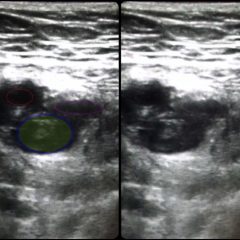Open Pneumothorax
History of present illness:
A 27-year-old male was transported to the emergency department by emergency medical services after crashing his motorcycle into a guardrail. Upon presentation he was alert, normotensive, and tachypneic.
Significant findings:
A large chest wound was clinically obvious. A chest radiograph performed after intubation showed subcutaneous emphysema, an anterior rib fracture, and a right-sided pneumothorax. He was then taken to the operating room for further management.
Discussion:
Thoracic injuries are responsible for one-quarter of all trauma-related deaths. Following rib fracture, pneumothorax is the second most common thoracic injury, occurring in 30% of patients with thoracic trauma. An open pneumothorax occurs when a chest wall injury results in direct communication between the atmosphere and pleura.1-2 It is estimated that open pneumothorax occurs in 80% of all penetrating chest wounds, with stab wounds being more common than gunshot wounds or impalement. Open pneumothoraces can lead to ventilatory insufficiency and rapid respiratory decompensation.2
Advanced Trauma Life Support recommends that the initial management of an open pneumothorax is placement of an occlusive dressing taped on three sides to create a ‘flutter-valve’ mechanism. This should then be followed by tube thoracostomy and repair of the chest wall defect.3 The placement of an occlusive dressing or initial wound closure without subsequent tube thoracostomy may result in the development of a tension pneumothorax.2
The patient was intubated and mechanical ventilation was initiated without complication. Due to the large size of the wound, an occlusive dressing was not placed in the emergency department and the patient was rapidly transported to the operating room for further management. In the operating room two chest tubes were placed. Operative findings included a right hemopneumothorax, multiple rib fractures, and a manubrial fracture.
After initial operative management, he was further stabilized in an intensive care unit. After several subsequent surgeries, he was discharged home.
Topics:
Pneumothorax, thoracotomy, thoracic, trauma.
References:
- Sharma A, Jindal P. Principles of diagnosis and management of traumatic pneumothorax. J Emerg Trauma Shock. 2008;1(1):34-41. doi: 10.4103/0974-2700.41789
- Kong VY, Liu M, Sartorius B, Clarke DL. Open pneumothorax: the spectrum and outcome of management based on Advanced Trauma Life Support recommendations. Eur J Trauma Emerg Surg. 2015;41(4):401-404. doi: 10.1007/s00068-014-0469-5
- American College of Surgeons. Advanced Trauma Life Support Student Manual. 9th Chicago, IL: American College of Surgeons; 2012.





